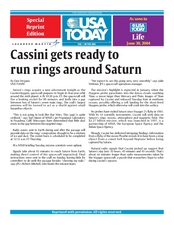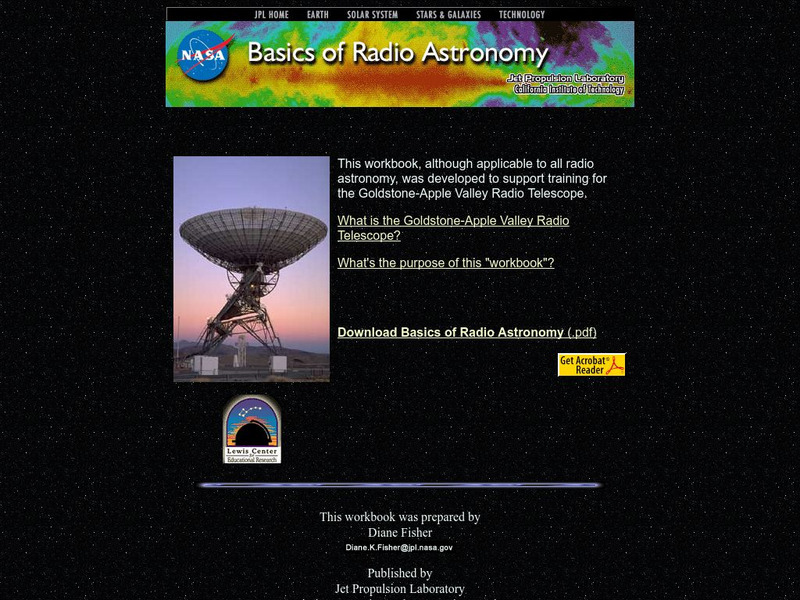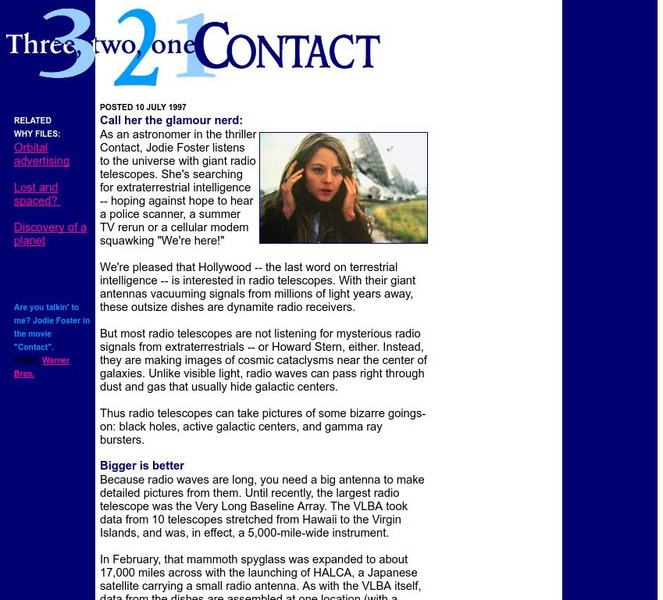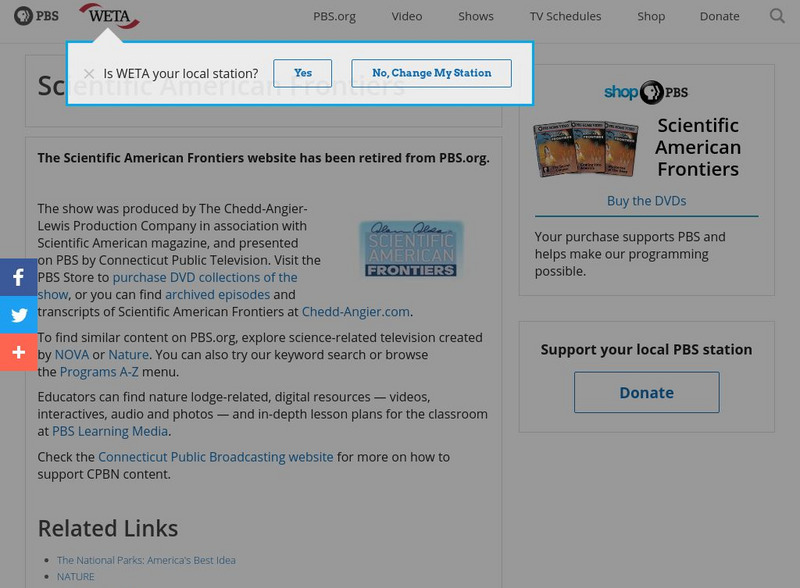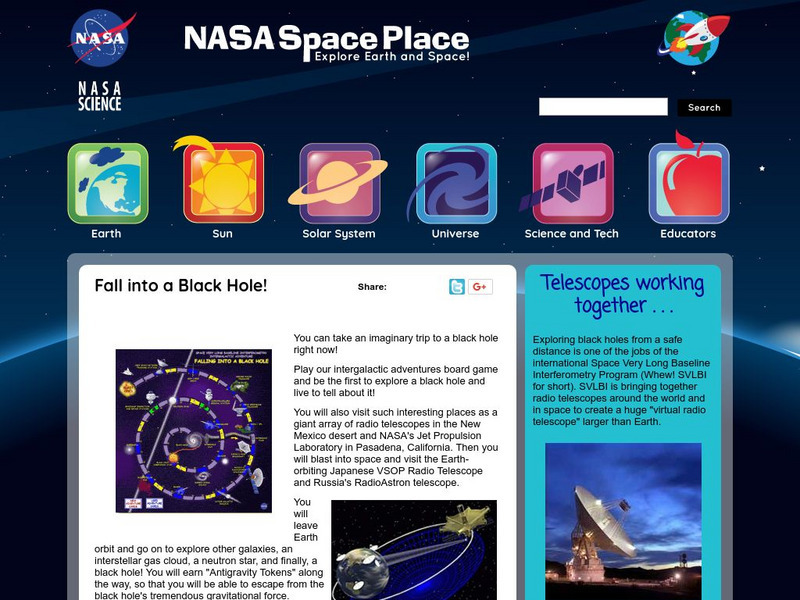Curated OER
Cassini gets Ready to run Rings Around Saturn
Fourth graders study an article about Saturn. For this investigative lesson students discuss the article and complete an activity that asks them what question they would pose about Saturn.
Wikimedia
Wikipedia: Radio Telescope
Wikipedia provides detailed information on radio telescopes, including an image, hyperlinked terms, and related topics.
Other
What Is Radio Astronomy?: Radio Astronomy at Vla and Vlba
Describes two radio telescopes run by the National Radio Astronomy Observatory (NRAO). The first telescope is called the Very Large Array (VLA) and the second is called the Very Long Baseline Array (VLBA). Both use radio interferometry....
NASA
Nasa: Basics of Radio Astronomy
Site developed by NASA to support training at the Goldstone-Apple Valley Radio Telescope. A manual in PDF format that covers everything from the basics of electromagnetic spectrum through radio sources through mapping the sky in the...
Texas Education Agency
Texas Gateway: What Are Telescopes Used For?
Scientists use telescopes to study the various components of the universe. How do telescopes work? Learn here about the electromagnetic spectrum and the various types of telescopes.
Harvard University
Harvard Smithsonian Center for Astrophysics: 1.2 Meter Millimeter Wave Telescope
Describes the collection of 1.2m millimeter wavelength radio telescopes that are operated by the Millimeter Wavelength Group at Harvard Smithsonian. It details some history of radio astronomy and of the telescope itself, gives great...
Other
Radio Sky Publishing: Site for Amateur Radio Astronomy
Site describes multiple resources for the beginner amateur radio astronomer. Great general information for beginners on basic radio physics and on the fundamentals of radio telescopes. Nice set of links to other useful sites.
CK-12 Foundation
Ck 12: Earth Science: Telescopes Study Guide
[Free Registration/Login may be required to access all resource tools.] This study guide summarizes key points about electromagnetic radiation and the different types of telescopes that rely on various forms of it. Includes a few...
University of Massachusetts
U Mass Astronomy: Five College Radio Astronomy Observatory
Resource provides basic information about the telescope and research projects being done there.
Other
Nrao: What Is Radio Astronomy?
This page contains an introduction to Radio Astronomy written by the National Radio Astronomy Observatory (NRAO). It contains some basic theory as well as frequently asked questions and teacher resources.
Curated OER
Wikipedia: National Historic Landmarks in West Virginia: Reber Radio Telescope
First parabolic radio telescope, built by amateur astronomer Grote Reber.
California Institute of Technology
Submillimeter Wave Astrophysics at Caltech: Caltech's Submillimeter Observatory
Homepage of a radio telescope operated by Caltech in Hawaii. This radio telescope focusses on submillimeter frequencies. Be sure to look at the General Information link for info on telescope and the Astrophysics link to find information...
Other
Nrao: Bringing Your Class to the Vla
Helps teachers arrange a trip to visit the radio telescope VLA. For those of you not near (New Mexico) it also gives connections into the physics, astronomy and electronics courses. It also has a healthy bibliography of sources.
NPR: National Public Radio
Npr: New Observatory Brings Stars Closer to Earth
A radio story describing the development of the newest technology in telescopes based on an old idea. Images of the 80-acre interferometer are shown on the site.
University of Wisconsin
The Why Files: 3 2 1 Contact, Don't Touch That Dial
A discussion of reflecting telescopes and their use in radio astronomy. The types of information gained from and the research emphasis fueled by such telescopes is described. Site uses Hollywood references and a humorous style.
University of California
U.c. Berkeley: Spectra From Space
View the entire spectrum of electromagnetic radiation and get information on telescopes especially designed to view different wavelengths of the spectrum.
Curated OER
Nasa: Basics of Radio Astronomy
Site developed by NASA to support training at the Goldstone-Apple Valley Radio Telescope. A manual in PDF format that covers everything from the basics of electromagnetic spectrum through radio sources through mapping the sky in the...
PBS
Pbs Teachers: Scientific American: Science in Paradise: Big Dish
Investigate the science of radio astronomy, and create a model of a curved reflecting dish that will work like the Arecibo detector to detect electromagnetic waves. Explore risk using a risk space grid.
Curated OER
Npoi Telescope
A radio story describing the development of the newest technology in telescopes based on an old idea. Images of the 80-acre interferometer are shown on the site.
NOAA
Noaa: National Weather Service: The Sun and Its Effect on the Earth [Pdf]
The Space Environment Center (SEC) put together a slide show for use by teachers on Space weather. Begin with discussing solar emission and the sun itself. Then end with a summary of climatic effects of space weather, and a note on space...
NASA
Nasa: Fall Into a Black Hole!
This site from the National Aeronautics and Space Administration allows one to play "Falling into a Black Hole," and take an imaginary trip to a black hole right now!
University of Houston
University of Houston: Engines of Our Ingenuity: No. 413: Edwin Hubble
Learn about Edwin Hubble and the impact his ideas had on the field of astronomy in this article, which is a transcript of a radio broadcast.
Curated OER
Aerial View of Npoi
A radio story describing the development of the newest technology in telescopes based on an old idea. Images of the 80-acre interferometer are shown on the site.
Curated OER
Npr: New Observatory Brings Stars Closer to Earth
A radio story describing the development of the newest technology in telescopes based on an old idea. Images of the 80-acre interferometer are shown on the site.


